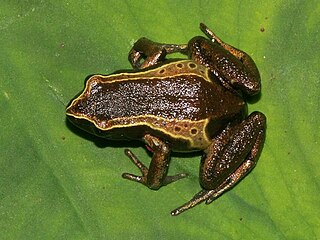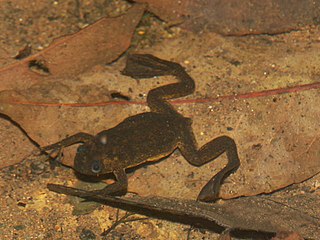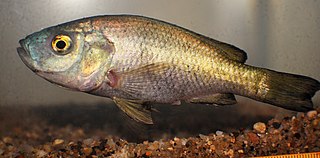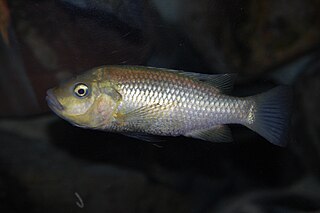 W
WAlexteroon jynx is a species of frogs in the family Hyperoliidae. It is endemic to the Rumpi Hills in southwestern Cameroon. Common name smooth egg-guarding frog has been proposed for it.
 W
WArchachatina camerunensis is a species of air-breathing tropical land snail, a terrestrial pulmonate gastropod mollusk in the family Achatinidae.
 W
WAstylosternus fallax, also known as the Fopouanga night frog, is a species of frog in the family Arthroleptidae. It is endemic to southwestern Cameroon where it is known only from between Yabassi and Nkongsamba, from Mount Yuhan in the Korup National Park, and from Mount Nta Ali in the Mamfe basin.
 W
WThe Cameroon sailfin chameleon, Trioceros montium, is a species of chameleon endemic to Cameroon. It has a very unusual appearance.
 W
WThe Cameroon worm lizard is a species of worm lizard in the family Amphisbaenidae. The species is endemic to Cameroon.
 W
WThe Cameroonian shrew is a species of mammal in the family Soricidae. It is endemic to Cameroon. Its natural habitat is subtropical or tropical moist montane forests. It is threatened by habitat loss.
 W
WCardioglossa oreas is a species of frog in the family Arthroleptidae. It is endemic to Cameroon and known from the Western High Plateau between Mount Oku and the Bamboutos Mountains. Records from Mount Manengouba refer to Cardioglossa manengouba.
 W
WClarias maclareni is a critically endangered species of catfish in the family Clariidae. It is endemic to Lake Barombi Mbo in western Cameroon. It is currently threatened because of pollution and sedimentation due to human activities, and potentially also by large emissions of carbon dioxide (CO2) from the lake's bottom (compare Lake Nyos). It is known to grow to 36 centimetres (14 in) TL. Large individuals feed mainly on other fishes (especially cichlids), while smaller individuals mainly feed on insects.
 W
WCoptodon kottae is an endangered species of fish in the cichlid family, Cichlidae. It is endemic to Lake Barombi-ba-Kotto and the smaller nearby Lake Mboandong in the Southwest Region of Cameroon.
 W
WCrotaphatrema lamottei, the Mount Oku caecilian or Lamotte's caecilian, is a species of caecilian in the family Scolecomorphidae. It is endemic to Mount Oku in Cameroon. The specific name lamottei honours Maxime Lamotte, French biologist. There is some doubt whether Crotaphatrema tchabalmbaboensis really is distinct from this species.
 W
WThe decorated running frog is a species of frog in the family Hyperoliidae. It is endemic to Cameroon where it is known from the Bamiléké highlands and from Mount Manengouba. There is uncertainty whether it is a valid species, and it has been also considered synonym of Kassina maculosa.
 W
WEuriphene aurivillii is a butterfly in the family Nymphalidae. It is found in Cameroon.
 W
WEuriphene tessmanniana is a butterfly in the family Nymphalidae. It is found in Cameroon.
 W
WHyperolius acutirostris is a species of frog in the family Hyperoliidae. It is endemic to southwestern Cameroon, found as far east as the region of Yaoundé. Common name sharpsnout reed frog has been coined for it.
 W
WIolaus schultzei, the Schultze's sapphire, is a butterfly in the family Lycaenidae. It is found in northern Cameroon. The habitat consists of dry savanna.
 W
WKribi killi is a species of African killifish that mainly inhabits swamps and turbid parts of brooks in the coastal rainforest. The species is endemic to Cameroon. Adult fish reach a maximum length of approximately 9 centimetres. Breeding pairs of the species most often lay their eggs over the bottom, but occasionally also among the roots of free-floating aquatic plants. Pairs stay close for some time, with just a few eggs being produced each day. It is sometimes kept in captivity but difficult to maintain and breed in an aquarium.
 W
WThe konye (Konia eisentrauti) is a critically endangered species of fish in the family Cichlidae. It is endemic to Lake Barombi Mbo, a crater lake in western Cameroon. It is threatened because of pollution and sedimentation due to human activities, and potentially also by large emissions of carbon dioxide (CO2) from the lake's bottom (compare Lake Nyos). This species can reach a length of 9.3 centimetres (3.7 in) TL.
 W
WThe Lake Oku clawed frog is a species of frog in the family Pipidae, endemic to Lake Oku, a small crater lake in northwest Cameroon. It is a small, dark-coloured, fully aquatic frog with a length of 28 to 36 mm, males being slightly smaller than females. The International Union for Conservation of Nature has rated this frog as "critically endangered" on the basis of its small area of occurrence at a single location, and the possibility that introduction of non-native fish into the lake could cause the frog to be wiped out.
 W
WLeptosiaphos koutoui is a species of skink, a lizard in the family Scincidae. The species is endemic to Cameroon and is only known from the Adamaoua Massif near Meiganga.
 W
WLeptosiaphos pauliani is a species of lizard in the family Scincidae. It is found in Cameroon.
 W
WThe Manenguba shrew is a species of mammal in the family Soricidae. It is endemic to Cameroon. Its natural habitat is subtropical or tropical moist montane forests.
 W
WMimacraea neavei is a butterfly in the family Lycaenidae. It is found in Cameroon.
 W
WThe Mount Cameroon forest shrew is a species of mammal in the family Soricidae endemic to Cameroon. Its natural habitat is subtropical or tropical moist montane forests.
 W
WThe myaka (Myaka myaka) is a critically endangered species of cichlid endemic to Lake Barombi Mbo in western Cameroon. It prefers open, deeper waters where it feeds on phytoplankton and small insects, only venturing into shallower waters to spawn. This species can reach a length of 6.7 centimetres (2.6 in) SL. It is currently the only known species in its genus, but it is very close to Sarotherodon. The myika is threatened because of pollution and sedimentation due to human activities. It is potentially also threatened by large emissions of carbon dioxide (CO2) from the lake's bottom (compare Lake Nyos), although studies indicate that Barombo Mbo lacks excess amounts of this gas. Konia, Pungu and Stomatepia are three other equally threatened genera of ciclids that also are endemic to Lake Barombi Mbo.
 W
WThe nsess (Stomatepia mariae) is a species of cichlid endemic to Lake Barombi Mbo in western Cameroon. It can also be found in the aquarium trade. It is critically endangered because of pollution and sedimentation due to human activities. It is potentially also threatened by large emissions of carbon dioxide (CO2) from the lake's bottom (compare Lake Nyos), although studies indicate that Barombo Mbo lacks excess amounts of this gas.
 W
WThe Oku mouse shrew is a species of mammal in the family Soricidae endemic to Cameroon. Its natural habitat is subtropical or tropical moist montane forests. It is threatened by habitat loss.
Pentila auga is a butterfly in the family Lycaenidae. It is found in southern Cameroon.
 W
WPetropedetes johnstoni is a species of frog in the family Petropedetidae. It is endemic to coastal Cameroon and known with certainty only from few localities. For a period, Petropedetes newtonii was considered a junior synonym of this species, leading to a much broader distribution. The two species are now considered distinct, but information on Petropedetes johnstoni sensu stricto is limited. Common name Johnston's water frog has been coined for this species.
 W
WPhrynobatrachus njiomock is a species of frogs in the family Phrynobatrachidae. It is endemic to Cameroon and is only known from Mount Oku where it occurs near Lake Oku. It has not been observed after 2010 and might already be extinct. The specific name njiomock means "eleventh" in Oku language and refers to the name "Phrynobatrachus sp. 11" that Jean-Louis Amiet used in 1978 to refer to a specimen collected near Lake Oku. Common name Lake Oku puddle frog has been proposed for this species.
 W
WThe pindu is a critically endangered species of cichlid endemic to Lake Barombi Mbo in western Cameroon.
 W
WThe pungu is a species of cichlid endemic to Lake Barombi Mbo in Cameroon where it prefers shallow waters of about 1 to 3 metres in depth. It feeds on invertebrates, sponges, diatoms and macrophytes. This species can reach a length of 10 centimetres (3.9 in) SL. It is currently the only known member of its genus, but it is very close to Sarotherodon. The pungu is threatened because of pollution and sedimentation from human activities. Konia, Myaka and Stomatepia are three other equally threatened genera of cichlids that also are endemic to Lake Barombi Mbo. The specific name of this fish honours the Fisheries Development Officer of Nigeria, P.I.R. MacLaren, who used his position to collect specimens of fishes, including the type of this species.
 W
WThe rain forest shrew is a species of mammal in the family Soricidae endemic to Cameroon. Its natural habitat is subtropical or tropical moist lowland forest. It is known only from its type locality, and from Kongana, Central African Republic.
 W
WSarotherodon linnellii, sometimes known as the unga, blackfin tilapia or blackbelly tilapia, is a cichlid endemic to Lake Barombi Mbo in western Cameroon. This species reaches a length of 18.5 centimetres (7.3 in) SL. It is critically endangered because of pollution and sedimentation due to human activities. It is potentially also threatened by large emissions of carbon dioxide (CO2) from the lake's bottom (compare Lake Nyos), although studies indicate that Barombo Mbo lacks excess amounts of this gas.
 W
WEisentraut's shrew is a species of mammal in the family Soricidae. It is endemic to Cameroon. Its natural habitat is subtropical or tropical high-altitude grassland.
 W
WStomatepia is a genus of cichlids endemic to Lake Barombi Mbo in western Cameroon. Although generally recognized as distinct, the genus is very close to Sarotherodon. The Stomatepia species are all recognized as critically endangered by the IUCN because of pollution and sedimentation due to human activities. They are potentially also threatened by large emissions of carbon dioxide (CO2) from the lake's bottom (compare Lake Nyos), although studies indicate that Barombo Mbo lacks excess amounts of this gas. Konia, Myaka and Pungu are three other equally threatened genera of ciclids that also are endemic to Lake Barombi Mbo.
 W
WThe volcano clawed frog is a species of frog in the family Pipidae endemic to Cameroon. Its natural habitats are subtropical or tropical high-altitude grassland, swamps, intermittent freshwater lakes, freshwater marshes, pastureland, and aquaculture ponds. It is threatened by habitat loss.